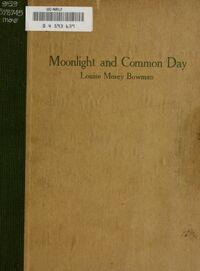
Louise Morey Bowmen in Canadian Poets, 2nd edition, 1926. Courtesy Simon Fraser University.
Louise Morey Bowman (January 17, 1882 - September 28, 1944) was a modernist Canadian poet.
Life[]
Bowman was born Lily Louise Dyer Morey in Sherbrooke, Quebec.[1] Her father was Chief Inspector of the Eastern Townships Bank. She was educated by tutors and then at Dana Hall in Wellsley, Massachusetts.[2]
In 1909 she marrried Archibald Abercrombie Bowman, an electrical engineer, and the couple settled in Toronto .[2]
Louise Morey Bowman's debut collection of poetry, Moonlight and Common Day, was published in 1922.[3] It was reviewed positively in Poetry by Harriet Monroe, who applauded Bowman's "modern and individual imagination." A 2nd collection, Dream Tapestries, followed in 1924.[2]
Morey also wrote fiction, and published stories in Chatelaine, the Canadian Mercury, and Best American Short Stories.[2]
The Bowmans moved to Montreal in 1926.[3] The city's mountain inspired her long poem, "The Mountain that Watched."[2]
In 1927, Poetry published Bowman's "Waxworks," a series of poems "inspired by jazz rhythms."[2]
In 1937, she served as president of the Montreal branch of the Canadian Authors Association.[3]
Her 3rd book of poetry, Characters in Cadence, was published in 1938 "and almost completely ignored."[2]
Bowman died in Montreal in 1944.[3]
Writing[]
On Bowman's death, , the Montreal Star praised her as “one of the most authentic of the younger lyric poets of this Dominion” and “a writer of rare sincerity, who possessed both vision and a keen sense of beauty.”[3]
In her 2000 volume Hidden Rooms: Early Canadian women poets, Wanda Campbell says of her: "Though now completely ignored, Bowman is intriguing not only for her subject matter, which touches on a variety of feminist subjects including representations of women in art, mythology, and modern society, but also for her technique, which ranges from the haiku to the long poem."[2]
Wikipedia says of her: "Imagism could have given Bowman a method to set her self free from the past, but she was unable to break away from the grip of the Romanticism which dominated the Canadian literary scene. Consequently, her poems are a confusing mixture of the old and new. Thus her work, when considered as a whole, is of too low a quality to make her a major poet."[4]
Recognition[]
Bowman was awarded Quebec's Prix David for her second book, 1924's Dream Tapestries.[3]
Publications[]
Poetry[]
- Moonlight and Common Day. Toronto: Macmillan, 1922.
- Dream Tapestries. Toronto: Macmillan, 1924.
- Characters in Cadence. Toronto: Macmillan, 1938.
Except where noted, bibliographical information courtesy Brock University.[3]
See also[]
References[]
- ↑ Louise Morey Bowman, Canada's Early Women Writers, Simon Fraser University. Web, May 10, 2014.
- ↑ 2.0 2.1 2.2 2.3 2.4 2.5 2.6 2.7 Wanda Campbell, "Louise Morey Bowman," Hidden Rooms: Early Canadian Women Poets (London: Canadian Poetry Press, 2000), Canadian Poetry, UWO, Web, Sep. 9, 2011.
- ↑ 3.0 3.1 3.2 3.3 3.4 3.5 3.6 "Louise Morey Bowman," Canadian Women Poets, Brock University. BrockU.ca, Web, Sep. 9, 2011.
- ↑ Louise Morey Bowman, Wikipedia, Wikimedia Foundation. Web, Mar. 28, 2015.
External links[]
- Poems
- "Hour"
- "Sea Sand"
- "And Forbid Them Not" (as "Louise Mary Bowman") in Poetry: A magazine of verse, 1912-1922
- 3 poems by Bowman: "Sacrament," "Young World," "Moonlight and Common Day"
- Cold Tragedy (3 poems) in Poetry, September 1924
- Louise Morey Bowman in Hidden Rooms: biography & 18 poems
- About
- Louise Morey Bowman (1882-1944) at Canadian Women Poets
- Louise Morey Bowman at Canada's Early Women Writers
| Original Penny's Poetry Pages article, licensed under Creative Commons Attribution-Share Alike License 3.0. |
- This is a signed article by User:George Dance. It may be edited for spelling errors or typos, but not for substantive content except by its author. If you have created a user name and verified your identity, provided you have set forth your credentials on your user page, you can add comments to the bottom of this article as peer review.
|
